The event horizon explained. Understanding the event horizon and navigating away from a black hole.
The scientific exploration of black holes has only recently gained serious momentum, despite the concept of their existence emerging in the nineteenth century. However, the notion of these celestial objects existing somewhere in the vastness of the cosmos was so incredible and virtually impossible to prove that it was rarely given serious consideration. In this latest installment of our “Simply Complex” series, we delve into the history of the discovery of these “frozen stars” and explore the mind-bending effects that occur to space and time at the boundaries of a black hole.
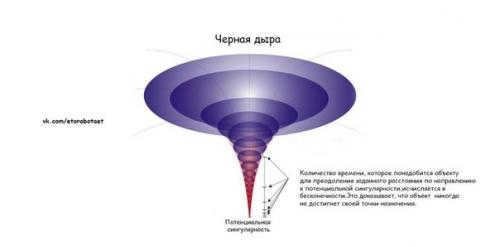
However, during the 19th century, scientists were not able to conceive of undetectable stars. The reason for this is that the Newtonian theory that light consists of particles had fallen out of favor. Scientists had reached the conclusion that the theory that light is a wave provides a better explanation for the phenomena observed in the world around us. Since nothing was known about how gravity interacts with waves, the idea of celestial objects “pulling” their own light had to be discarded.
Once again, the topic of black holes comes to mind, but this time with a twist. It was only in the 20th century that these mysterious objects started gaining attention. In 1916, shortly after Einstein’s general theory of relativity was published, Karl Schwarzschild introduced the concept of a “Frozen Star” to describe these enigmatic entities. However, Schwarzschild did not delve into the process of their formation. It wasn’t until 1939 that Robert Oppenheimer and Hartland Snider filled in this missing piece of the puzzle. They added the crucial element to the theory, shedding light on the origins of black holes.
It took another three decades for the term “Black Hole” to be coined by American physicist John Wheeler in 1969. Wheeler, who had a penchant for romance, also popularized the term “wormhole,” which has since captured the imaginations of science fiction writers.
The life cycle of a star resembles that of a human being – it is born and it dies. Initially, a vast cloud of gas (predominantly hydrogen) in outer space starts to contract due to its own gravitational force, causing its molecules to collide more frequently and their velocities to increase. As a result, the gas becomes hotter, and when it reaches a certain temperature, a fusion reaction takes place, generating helium. This reaction releases heat and emits light, leading to the formation of a star. The heat generates additional pressure, balancing the gravitational force, and the star ceases to contract, existing in a stable state for over a million years. However, eventually, the star’s supply of hydrogen for fusion reactions becomes depleted, causing it to cool down and contract.
Once the comparison to human existence concludes, the destiny of the celestial body is determined by its mass. Diminutive stars transform into white dwarfs, entities possessing a density of hundreds of tons per cubic centimeter. These entities are abundant in the vastness of space, and eventually, our sun will join their esteemed ranks. Larger stars, on the other hand, give rise to neutron stars. While their size is significantly smaller than that of white dwarfs, their density reaches hundreds of millions of tons per cubic centimeter.
Lastly, should the star possess a substantial mass, the gravitational forces will relentlessly compress the neutron star until it morphs into a black hole.
The notion that nothing can escape from a black hole was steadfast until the 1970s. However, in 1974, Stephen Hawking postulated that black holes emit various elementary particles, particularly photons, as a consequence of quantum processes. In the 2010s, multiple groups of scientists in controlled laboratory conditions have validated his hypothesis. Nevertheless, this radiation has not been observed in nature, just like the black holes themselves – the Nobel Prize for their discovery still awaits its recipient.
What is the event horizon of a black hole explained in simple terms. Different types of event horizons
When we think of the event horizon, we typically think of black holes. It’s the impenetrable boundary, the outer shell of a black hole. Beyond this shell lies something that is beyond the perception of an external observer and even the laws of physics as we know them. However, the event horizon is not exclusive to black holes. It is simply a specific manifestation of it.
The event horizon is defined as a conditional boundary that separates two sets of events. There are two types of event horizons – the past event horizon and the future event horizon. The past event horizon separates events that can be changed from events that cannot be changed. The future event horizon separates other sets of events. At some point, the observer will be able to learn about all the events in the first set. However, there will always be events in the second set that the observer will never know about.
A black hole has a past event horizon, which can also be observed by someone who is moving with relativistically uniform acceleration. The observable part of the universe has a future event horizon. These different types of event horizons will be discussed in more detail below.
How to escape the clutches of the event horizon. No way to break free
Einstein’s groundbreaking achievement was the revelation of the true nature of gravity. He demonstrated that gravity is, in fact, the bending of space itself. When massive objects are present, space “warps” just like a stretched elastic fabric with a heavy object placed on it. Drawing a parallel, we can imagine the Sun as a massive ball and the Earth as a much smaller ball, not being pulled towards it but rather orbiting within the resulting gravitational vortex (with the only distinction being that a physical ball would eventually roll down).
Inside a black hole, the curvature of space-time becomes infinitely extreme – physicists refer to this state as singularity, where our conventional understanding of space and time ceases to exist.
The Event Horizon for Beginners. Ask Ethan: what ought to the appearance be of a black hole’s event horizon?
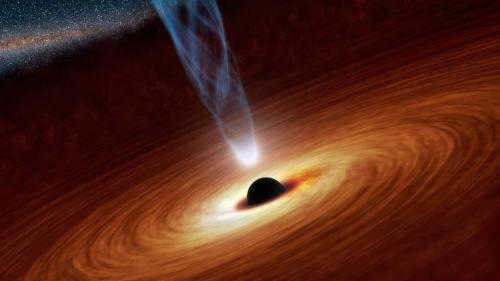 An image of a black hole is presented. It is commonly believed that all black holes are formed from ordinary matter, although such depictions are not entirely accurate. In April 2017, telescopes from around the world gathered data on the central black hole of the Milky Way. Among all the known black holes in the universe, the one at the center of the galaxy, Sagittarius A*, is particularly interesting. From our perspective, its event horizon is the largest of all the black holes available for observation. It is so large that if telescopes from different locations on Earth were all pointed at it simultaneously, they would be able to capture its image. Although it will take several months to combine and analyze the data from these telescopes, we should have our first image of the event horizon by the end of 2017. One of our readers is confused by the illustrations and asks why the event horizon of a black hole does not completely surround the black hole like an eggshell. Many artists depict black holes as cut hard-boiled eggs. So, which illustrations are correct?
An image of a black hole is presented. It is commonly believed that all black holes are formed from ordinary matter, although such depictions are not entirely accurate. In April 2017, telescopes from around the world gathered data on the central black hole of the Milky Way. Among all the known black holes in the universe, the one at the center of the galaxy, Sagittarius A*, is particularly interesting. From our perspective, its event horizon is the largest of all the black holes available for observation. It is so large that if telescopes from different locations on Earth were all pointed at it simultaneously, they would be able to capture its image. Although it will take several months to combine and analyze the data from these telescopes, we should have our first image of the event horizon by the end of 2017. One of our readers is confused by the illustrations and asks why the event horizon of a black hole does not completely surround the black hole like an eggshell. Many artists depict black holes as cut hard-boiled eggs. So, which illustrations are correct?
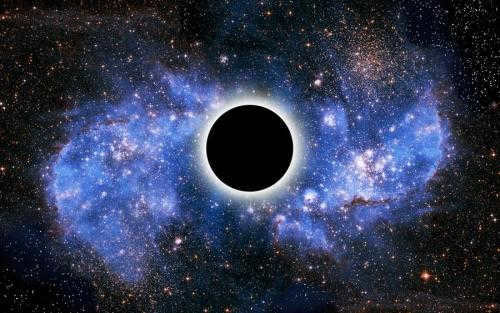 A simple black circle with a ring around it is an oversimplified representation of a black hole’s horizon. The oldest type of illustration shows a black disk that covers all the light behind it. This makes sense when considering what a black hole is: an incredibly massive and compact object where the escape velocity from its surface exceeds the speed of light. As nothing can move that fast, not even the transmission of interactions between particles within the black hole, the interior collapses to a singularity and an event horizon forms around the black hole. Light cannot escape from this spherical region of space, which is why, from any perspective, it appears as a black circle superimposed on the background of the Universe.
A simple black circle with a ring around it is an oversimplified representation of a black hole’s horizon. The oldest type of illustration shows a black disk that covers all the light behind it. This makes sense when considering what a black hole is: an incredibly massive and compact object where the escape velocity from its surface exceeds the speed of light. As nothing can move that fast, not even the transmission of interactions between particles within the black hole, the interior collapses to a singularity and an event horizon forms around the black hole. Light cannot escape from this spherical region of space, which is why, from any perspective, it appears as a black circle superimposed on the background of the Universe.
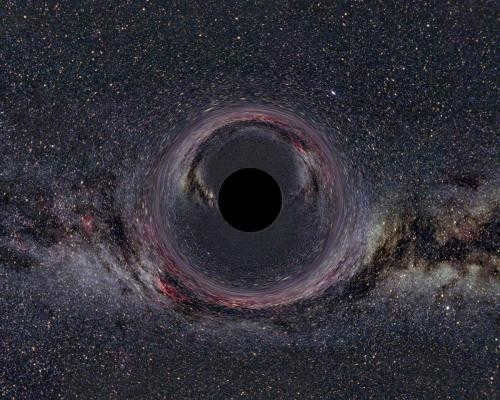 The event horizon of a black hole has gravitational effects that stretch, magnify, and distort light due to gravitational lensing. However, these illustrations also have their flaws. They do not take into account the material in front of the black hole and the accretion disk around it. Some images do include these additional features.
The event horizon of a black hole has gravitational effects that stretch, magnify, and distort light due to gravitational lensing. However, these illustrations also have their flaws. They do not take into account the material in front of the black hole and the accretion disk around it. Some images do include these additional features.
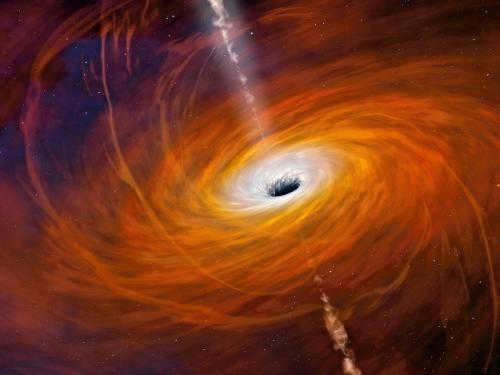 An accurate description of the black hole in the center of our galaxy includes an active event horizon occupied by an accretion of matter and the acceleration of its parts in the form of two perpendicular jets.
An accurate description of the black hole in the center of our galaxy includes an active event horizon occupied by an accretion of matter and the acceleration of its parts in the form of two perpendicular jets.
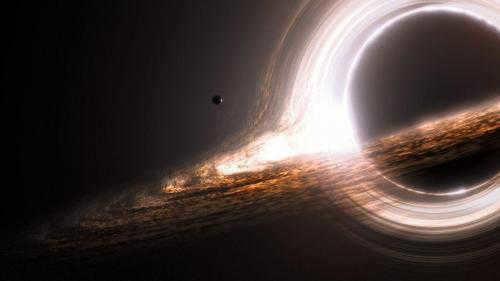 The movie Interstellar depicts a black hole with a fairly accurate event horizon for a special class of rotating black holes.
The movie Interstellar depicts a black hole with a fairly accurate event horizon for a special class of rotating black holes.
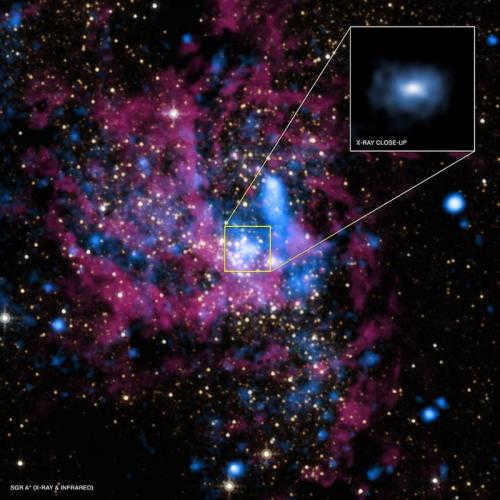 A composite image of the Sagittarius A* event horizon at the center of our galaxy, composed of X-rays and infrared, shows a mass of 4 million solar masses surrounded by hot gas radiating in the X-ray range.
A composite image of the Sagittarius A* event horizon at the center of our galaxy, composed of X-rays and infrared, shows a mass of 4 million solar masses surrounded by hot gas radiating in the X-ray range.
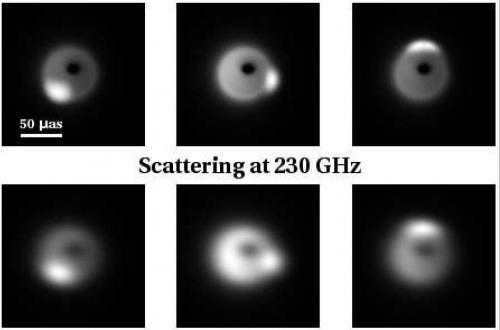 Some simulations of the event horizon of a black hole, obtained from the “Event Horizon Telescope” project, show possible signals of the event horizon.
Some simulations of the event horizon of a black hole, obtained from the “Event Horizon Telescope” project, show possible signals of the event horizon.
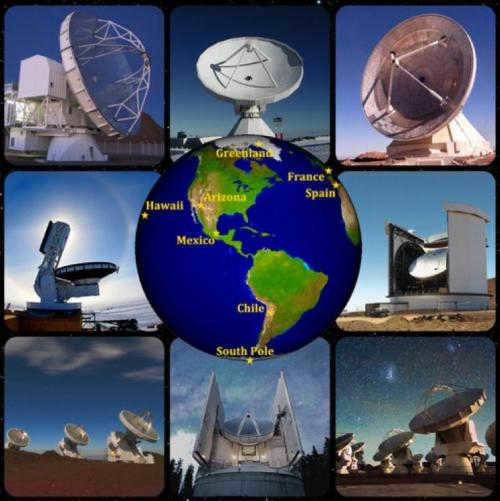 Parts of the Event Horizon Telescope from one hemisphere.
Parts of the Event Horizon Telescope from one hemisphere.
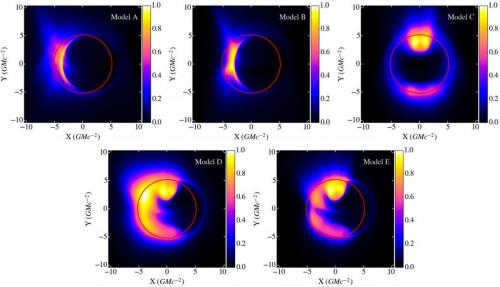 Five different simulations in general relativity using the magnetohydrodynamic model of the accretion disk of the black hole, and the resulting signals.
Five different simulations in general relativity using the magnetohydrodynamic model of the accretion disk of the black hole, and the resulting signals.
The images of hard-boiled eggs are not of the black hole itself, as it does not emit light. Instead, we observe a combination of light curving around and in front of the black hole, as well as light coming from behind it. The resulting signal can resemble a cut-in-half hard-boiled egg.
We are unable to observe in certain ranges of wavelengths, such as X-ray and visible light, due to various factors. However, we can observe in the radio band, which allows for simultaneous observations around the world to achieve the best possible resolution.
The angular size of the black hole at the center of the galaxy is about 37 angular microseconds, while the resolution of the telescope is 15 angular microseconds. Therefore, we should be able to see it! Most of the radio frequency radiation comes from charged particles of matter accelerating around the black hole. The orientation and structure of the disk are still unknown, but they greatly affect what we can see.
We expect to find a real event horizon of a certain size that blocks all light coming from behind it. The shape of the event horizon may be round, elongated, or flattened at the poles. The radio emissions may extend farther than anticipated, and there may be other deviations from expected behavior. This is an exciting new phase of physics, and we are on the cusp of directly testing it. Regardless of what the Event Horizon Telescope observes, we will undoubtedly learn something new and remarkable about these extreme objects and conditions in the Universe!
Ethan Siegel is an astrophysicist, science popularizer, and author of the blog Starts With A Bang! He has written the books Beyond the Galaxy and Treknology: The Science of Star Trek.
Video: How can one escape the event horizon?
There is a potentially paradoxical statement that black holes may not be limited by an event horizon. This hypothesis has been put forth by renowned theoretical physicist Stephen Hawking. Hawking’s presentation of this concept has changed the way we perceive black holes, as they are no longer seen as completely “black” and “immortal.”
However, understanding and accepting this idea is not a simple task. First and foremost, it is important to grasp the concept of an event horizon.
Black holes are commonly associated with the event horizon, which acts as an impenetrable boundary surrounding them. This shell conceals something that is beyond the perception of both external observers and the laws of physics. However, it is important to note that the event horizon is not exclusive to black holes and can be found in other phenomena as well.
The event horizon is commonly defined as a boundary that separates two sets of events. There are two types of event horizons – the past event horizon and the future event horizon. The past event horizon separates events that can be changed from events that cannot be changed. On the other hand, the future event horizon separates different sets of events. An observer can eventually learn about all the events within the first set, while the second set contains events that will forever remain unknown to the observer.
A black hole has a past event horizon, which can also be observed by someone who is moving with relativistic uniform acceleration. The observable part of the universe has a future event horizon. These different types of event horizons will be discussed in more detail below.
Exploring the depths
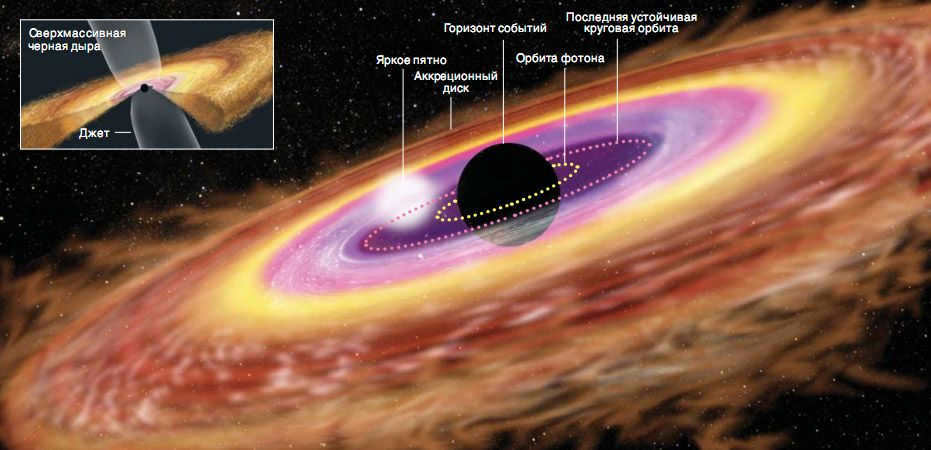
Event Horizon of a Black Hole
Black holes provide a convenient platform for theoretical physicists to explore and illustrate various phenomena that are difficult to explain. One popular example in popular science involves a fictional starship falling into a black hole and being observed by an outside observer. This example effectively demonstrates certain characteristics of the event horizon.
According to the theory of relativity, the journey to the event horizon would be unremarkable for the passenger aboard the starship. They would experience increasing acceleration until reaching the speed of light at the event horizon. However, the observer would witness a different scene. As the starship approaches the black hole, its silhouette would appear to stretch and slow down. At the event horizon, it would appear frozen in time.
There is still much scientific uncertainty surrounding what occurs to the starship once it crosses this boundary. It is probable that from the perspective of a starship passenger, the ship will continue to accelerate after surpassing the speed of light. It is important to consider that the entirety of a black hole’s mass is concentrated within its center, an infinitesimally small singularity. As a result, the remaining space within the black hole is merely a region confined by the event horizon.
A fresh perspective on emptiness
Additional resources
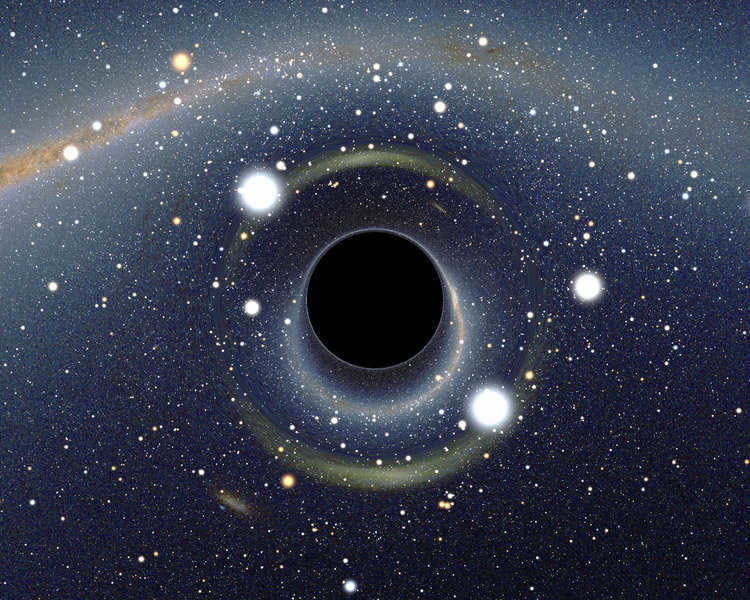
Put simply, the term “black hole radius” does not refer to the size of a physical object. Instead, it represents the size of the area where conventional physics no longer applies. Once inside this area, our starship will be unable to escape and will inevitably be pulled towards the center of the black hole.
An interesting aspect of the event horizon is that, from the perspective of an outside observer, there does not appear to be a singularity. Anything that falls into the black hole from our external world will forever remain on the edge of the event horizon. This means that, from our point of view, all of the black hole’s mass is concentrated on the outer edge rather than at the center. The starship will not only fail to reach the center, but it will also be unable to cross the boundary of the black hole.
However, for those trapped within the gravitational pull of a black hole, the moment they cross the event horizon will feel as though it is happening at the speed of light. As they continue their journey towards the singularity, their speed will only increase, defying the laws of physics as we understand them. Ultimately, any object that falls into a black hole will inevitably become a part of the singularity. From the perspective of the object, this process may occur relatively quickly, while outside the black hole, the familiar universe as we know it may cease to exist. This aligns with Hawking’s theory, which suggests that black holes can evaporate in an unbelievably brief span of time.
The Size of the Event Horizon
The event horizon, together with the singularity, is the primary characteristic of a black hole. Its size, also known as the gravitational radius or Schwarzschild radius, is directly proportional to its mass. To get an approximate estimation of the size of any black hole, you can simply multiply three kilometers by the ratio of its mass to the mass of the sun. For instance, a black hole with the mass of the Earth would have the size of a cherry tree. In contrast, supermassive black holes can have sizes measured in millions or even billions of kilometers.
What’s fascinating is that the dimensions of a black hole with the mass equivalent to that of the observable Universe are significantly smaller than the actual size of the Universe. It’s important to mention the concept of the event horizon, which acts as a barrier surrounding our observable Universe. This means that anything beyond the event horizon is concealed from the observer, much like a starship inside a black hole.
The Event Horizon that Applies to Everything
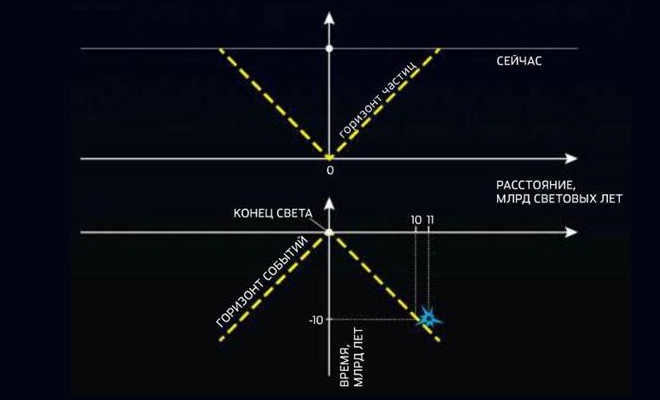
What lies beyond the events horizon and the Hubble sphere?
The event horizon differs somewhat from the particle horizon. It filters out events in our universe that will remain unknown to us. Its radius is several billion light years larger than the radius of the Hubble sphere.
All three of these parameters rely directly on the observer. This is one of the distinctions between the event horizon of a black hole and the event horizon of the Universe. In other words, the event horizon of a black hole is not influenced by the locations of different observers. Conversely, each observer, depending on their location, will perceive the boundary of the Universe differently. It is akin to how the horizon appears different from various points on the planet’s surface.
Rindler horizon
There is also a Rindler horizon for an observer who is moving with relativistic acceleration. This horizon, like the event horizon of a black hole, has similar properties. It emits radiation similar to the radiation emitted by evaporating black holes.
The Rindler horizon is named after its discoverer, Wolfgant Rindler, who also coined the term “event horizon”.
Visible horizon
The visible horizon refers to the line or boundary where the Earth’s surface and the sky appear to meet. It is the apparent boundary between the land or sea and the sky when viewed from a specific vantage point. The visible horizon can vary depending on factors such as the observer’s elevation and the curvature of the Earth. It is an important concept in navigation and astronomy, as it helps to determine the visibility of distant objects and the limits of one’s perception.
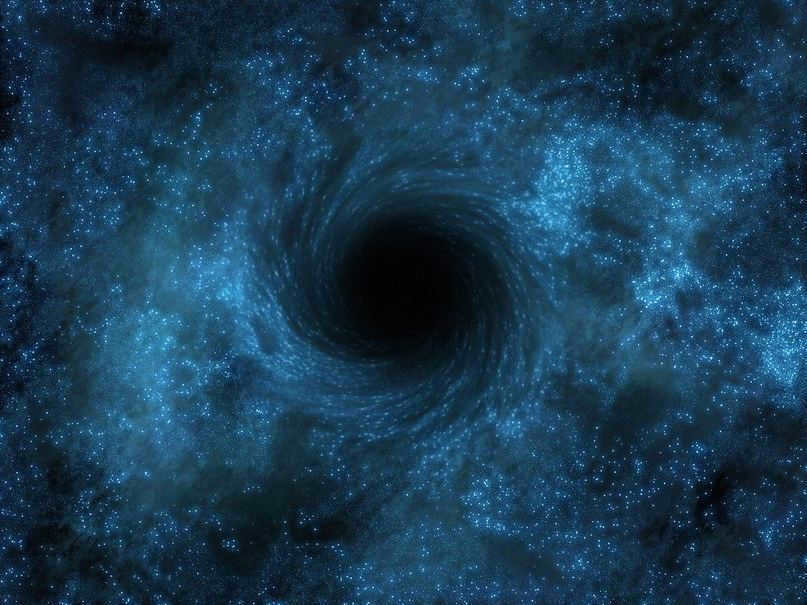
An artist’s rendering of a black hole
Now we have gained an understanding of how modern science perceives the event horizon. It appears that Stephen Hawking sought to challenge the existence of this phenomenon. In reality, his new hypothesis aimed to address the controversies surrounding black holes.
The emerging field of quantum theory has transformed black holes into entities capable of emitting radiation. According to this quantum model, the event horizon for our starship will no longer be a conventional boundary. Instead, the “new” quantum event horizon, which contains a high concentration of energy, will completely obliterate the starship. However, it is important to remember that, based on the principles of relativity theory, the starship should pass through this boundary without any obstacles.
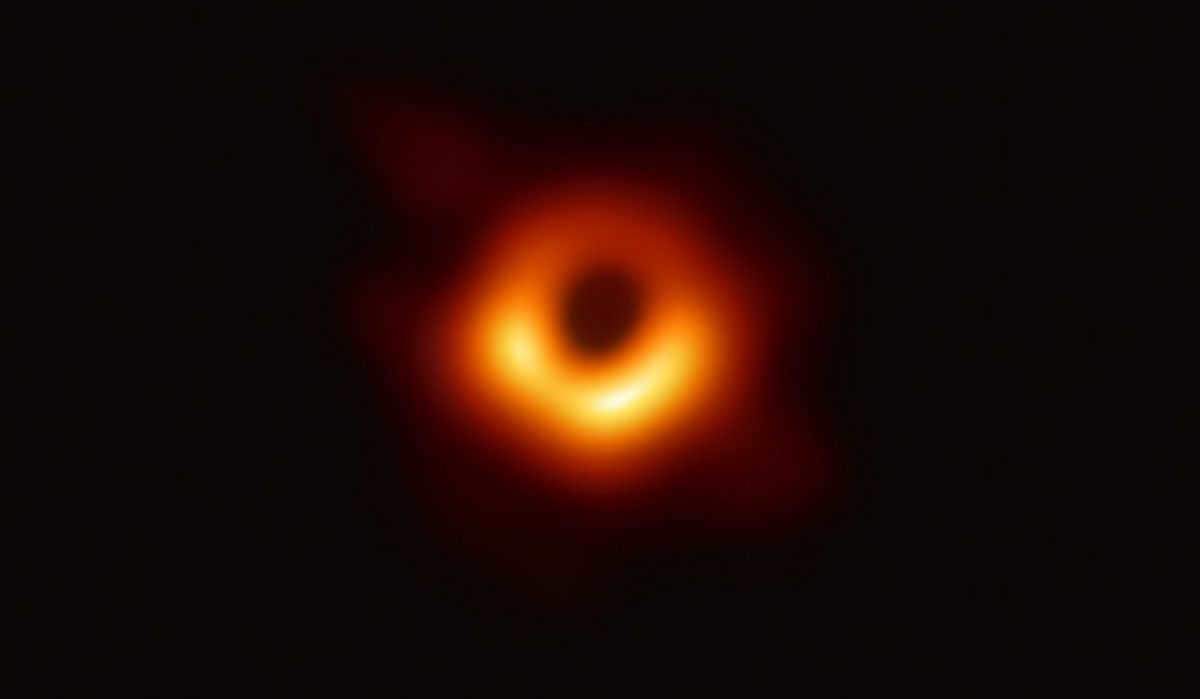

The initial direct visual representation of a supermassive black hole and its silhouette situated at the core of the M87 galaxy
Therefore, adjustments have been made to the existing concepts regarding the event horizon. Presently, the event horizon merely temporarily retains what it has acquired. As the black hole evaporates, the information will ultimately reemerge beyond the horizon, albeit in a distorted manner. Nonetheless, even Hocking himself acknowledges that his idea is no more than a hypothesis. He underscores the fact that scientists still have much to uncover before they can confidently discuss the event horizon.
Hero of the science fiction genre
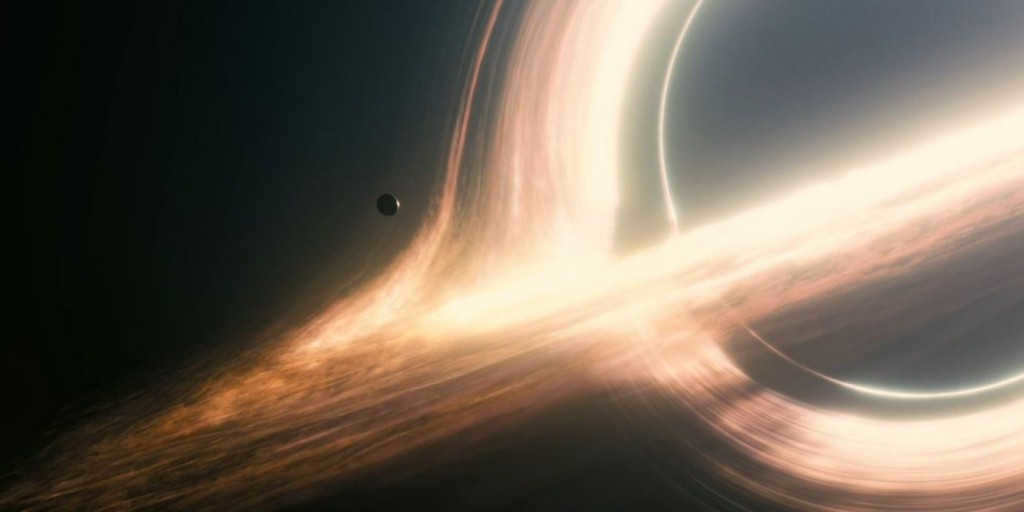

Gargantua’s black hole featured in the film Interstellar
Without a doubt, the enigmatic and uncharted nature of the event horizon will continue to captivate the imaginations of sci-fi authors for years to come. Frequently, the event horizon is portrayed as a doorway to distant realms of space, time, or dimensions. Fiction writers have the liberty to ascribe various characteristics to it, as current scientific knowledge is still unable to challenge their creativity.
One notable example in this realm is the film “Interstellar” directed by Christopher Nolan.
An application has been developed for individuals who aspire to experience the sensation of being a protagonist in the film “Interstellar”. This online model of a black hole mimics the curvature of space surrounding the celestial entity. By utilizing this program, one can witness the event horizon from a variety of perspectives and estimations. Accompanied by the soundtrack from “Interstellar”, users have the opportunity to immerse themselves in the event horizon, observing the dynamic alteration of both the cosmic allure and the coordinate grid.
- The event horizon represents a conceptual limit in the fabric of space-time that distinguishes between events that can be connected to events at light-like (isotropic) infinity by light-like geodesic lines (the paths of light rays), and events that cannot be connected in this way. In most cases, there are two light-like infinities in a given space-time: one in the past and one in the future, resulting in two event horizons: the past event horizon and the future event horizon. Put simply, the past event horizon separates events that are subject to change from those that are not, while the future event horizon separates events that can be known, at least in the infinitely distant future, from events that cannot be known.
The event horizon is typically a three-dimensional hypersurface. The presence of a spatially similar light-like (isotropic) infinity is both a necessary and sufficient condition for its existence. It is important to note that the event horizon is an integral and non-local concept, as its definition involves the entirety of light-like infinity, encompassing all infinitely distant regions of space-time. Consequently, in its immediate vicinity, the event horizon lacks any distinguishing features, which poses a challenge for numerical calculations within the framework of general relativity. To address this issue, alternative concepts that are locally defined but closely related to the event horizon have been proposed, such as the dynamic horizon, trap surface, and apparent horizon.
Associated ideas
The concept of Hawking radiation involves the theoretical process of a black hole emitting a variety of elementary particles, particularly photons. This phenomenon is named after the renowned physicist Stephen Hawking. Hawking radiation is a significant point of discussion among scientists regarding the potential decay or evaporation of small black holes, which may occur during experiments conducted at the Large Hadron Collider (LHC). This effect forms the foundation for the concept of a singular reactor, a device that harnesses energy from a black hole through the utilization of Hawking radiation.
In the field of cosmology, dark energy is a theoretical form of energy that is incorporated into mathematical models of the Universe to provide an explanation for its observed accelerated expansion.
The expansion of the Universe is a remarkable occurrence characterized by a nearly uniform and symmetrical expansion of outer space across the entire expanse of the Universe, deduced from the cosmological redshift observed from Earth.
Cosmological singularity, on the other hand, refers to the state of the Universe in a specific moment in the past when the energy (matter) density and curvature of space-time were incredibly immense, reaching the magnitude of Planck values. This particular state, along with the subsequent stage in the evolution of the Universe when the energy (matter) density remained high, is also known as the Big Bang. The cosmological singularity serves as an example of the gravitational singularities that are predicted by the general theory of relativity (GTR) and.
References in the written works
Regardless of the circumstances, the ability to travel vast distances, which even the speed of light requires substantial time to accomplish, would not have been feasible even with the introduction of a revolutionary super-powered fuel. However, humanity has harbored a deep desire for such voyages for so long that one could even speak of an elusive utopia that exists somewhere in the depths of the universe, yet remains to be discovered and attained. In the 20th century, the concept of relativity began to make significant strides. In 1935, the theory proposed by A. Einstein and mathematician N. Rosen, known as the “Einstein-Rosen bridge,” suggested that movement within the universe is possible through the use of wormholes that connect different points in the three-dimensional world through a shorter path in the fourth dimension. Since 1989, there has been a resurgence of theoretical articles on time travel through the utilization of wormholes and black holes in scientific publications. Black holes are regions of space where the gravitational pull is so intense that neither matter nor radiation can escape. A black hole is separated from the rest of space by an “event horizon” – a boundary where the cosmic velocity is equal to the speed of light. Since nothing in nature can surpass this speed, no medium can elude the event horizon. Therefore, the interior of a black hole has no causal relation to the rest of the universe; the physical processes occurring within the black hole’s depths cannot influence the processes outside of it. However, matter and radiation that fall from the outside onto the black hole can freely pass through the event horizon.
This is the explanation of a black hole. Its gravitational pull is so strong that anything that enters it is unable to escape. Artists sometimes depict black holes as a massive funnel in space, but from the outside they resemble more of a planet: a large, mysteriously dark planet. Matter can orbit around it, which is typically the case. However, if one were to attempt to touch what appears to be its surface, their hand would simply pass through: this object is actually empty space. The supposed surface, known as the “event horizon”, is essentially a theoretical point of no return, where any gas or matter that hits it can only change direction if it exceeds the speed of light. In the case of Sagittarius A*, the event horizon is a spherical shape with a diameter of approximately 25 million kilometers. Matter that crosses it continues to move forward, much like a car that has entered a dead-end one-way street and is accelerating towards an uncertain and likely grim fate. “This is the distinguishing characteristic of a black hole,” Narayan explains. – A black hole lacks a physical surface, and this fact alters everything. The gas and all its accompanying energy are simply consumed.
“Our hope is to come closer to what is known as the event horizon. The event horizon refers to the boundary around a black hole where any object falling into it would vanish. This region near the black hole experiences intense gravitational forces, leading to various extraordinary properties.”
“This is the process by which a star transforms into a black hole. This implies that its gravitational pull is so immense that even light cannot escape. The interface between the interior and exterior of a black hole is referred to as the event horizon. Scientists believe that massive black holes, some millions of times larger than our Sun, lie at the center of nearly every galaxy, including our own Milky Way.”
Further concepts (ongoing)
The ergosphere denotes a specific region in the spacetime vicinity of a rotating black hole, positioned between the event horizon and the static limit. Within the ergosphere, objects are unavoidably compelled to rotate in sync with the black hole, primarily because of the Lense-Thirring effect.
Momentum (also referred to as kinetic momentum, angular momentum, orbital momentum, or momentum of motion) delineates the extent of rotational motion. The precise value depends on various factors, such as the amount of mass that is undergoing rotation, its distribution relative to the axis of rotation, and the speed at which the rotation takes place.
A black hole is a region in space-time where the gravitational pull is so strong that nothing, not even light, can escape from it. The boundary of this region is known as the event horizon, and its size is referred to as the gravitational radius. In the case of a spherically symmetric black hole, this radius is equal to the Schwarzschild radius.
Spacetime, also known as the spacetime continuum, is a physical model that incorporates time as a fourth dimension along with the three dimensions of space. This creates a theoretical and physical framework known as a spacetime continuum. Spacetime is continuous and can be mathematically described as a manifold with a Lorentzian metric.
Black-hole cosmology, also known as “Schwarzschild cosmology” or “black-hole cosmological model,” is a cosmological concept that suggests the observable universe, or Metagalaxy, exists within a black hole. This idea was first proposed in 1972 by Raj Patria, an Indian theoretical physicist, and simultaneously by Irwin Goode, a British mathematician.
The gravitational field, also called the gravitational field, is a fundamental physical field that facilitates gravitational interaction between all material bodies.
The concept of hidden mass addresses the discrepancy between the observed behavior of visible astronomical objects and their behavior calculated using the laws of celestial mechanics, which only consider these objects.
The deceleration of the Universe’s expansion can be observed through the decrease in luminosity of distant “standard candles” known as Type Ia supernovae. These supernovae were detected in the late 1990s and their dimming is interpreted as evidence for the acceleration of the Universe’s expansion.
The theory of general relativity encompasses a range of effects. In weak gravitational fields and with slow-moving bodies, it reproduces the predictions of Newton’s theory of gravitation, as expected from the correspondence principle. However, it is in strong gravitational fields, such as those found in compact astrophysical objects, and with objects moving at relativistic speeds, that the distinct effects of general relativity become apparent. These effects include the deflection of light. In the case of weak fields, the general theory of relativity also makes accurate predictions.
Relativistic time dilation is a phenomenon described by the special theory of relativity, which states that in a moving body, all physical processes occur at a slower rate compared to a stationary body in the frame of reference of the laboratory system.
Spaghettification is a term used in astrophysics (also known as the noodle effect) to describe the significant stretching of objects (similar to spaghetti) caused by a powerful tidal force in a highly non-uniform gravitational field. In extreme cases, such as when objects are in close proximity to black holes, the deformation from this stretching is so intense that no object can maintain its structural integrity.
The Friedmann Universe, also known as the Friedmann-Lemeter-Robertson-Walker metric, is a cosmological model that satisfies the field equations of the general theory of relativity (GR). It was first proposed by Alexander Friedman in 1922. The model describes a non-stationary Universe that is homogeneous, isotropic, and has matter with either positive, zero, or negative constant curvature. Friedman’s work on this model was a groundbreaking theoretical development.
Dark matter, both in astronomy and cosmology, as well as in theoretical physics, is a hypothetical form of matter that does not emit electromagnetic radiation and does not directly interact with it. This property of dark matter makes it challenging, and perhaps even impossible, to observe it directly.
Gravitational collapse refers to the extremely rapid compression of massive objects due to the influence of gravitational forces. This phenomenon can occur when stars with a mass greater than three times that of the Sun reach the end of their evolutionary cycle. Once these stars have exhausted their fuel for thermonuclear reactions, they lose their mechanical stability and start to collapse towards their core at an accelerating rate. If the increasing internal pressure is able to counteract the gravitational contraction, the central region of the star can become a superdense neutron star.
In the theory of relativity, a world line is a curve in space-time that describes the motion of a body, which is treated as a material point. It represents the geometric path of all the events that occur during the existence of the body. The term “world line” can also be used more generally to describe any continuous line in space-time.
Gravitational redshift, in the field of physics, occurs when the frequency of light (or any electromagnetic waves) emitted by an object changes as it moves farther away from massive celestial bodies like stars and black holes. This shift can be observed as a displacement of spectral lines towards the red end of the spectrum in the emitted light from sources near these massive objects. Conversely, light originating from areas with a weaker gravitational field undergoes a gravitational blue shift.
The Schwarzschild metric is an exact solution to the Einstein equations that describes the gravitational field around a non-rotating and uncharged black hole, as well as the field outside a massive spherically symmetric body. This metric was discovered by Karl Schwarzschild in 1916 and is the only spherically symmetric solution without a cosmological constant in empty space, thanks to Birkhoff’s theorem.
The General Theory of Relativity (GTR) is a geometric theory of gravitation that builds upon the special theory of relativity (STR) proposed by Albert Einstein in 1915-1916.
The cosmic ultrahigh-frequency background radiation, also known as relict radiation (from the Latin word “relictum” meaning “remnant”), is a form of thermal radiation that is evenly distributed throughout the Universe. This radiation originated during the epoch of primary recombination of hydrogen. It exhibits a high level of isotropy and has a spectrum that is characteristic of a perfectly black body with a temperature of 2.72548 ± 0.00057 K.
Gravity, also known as gravitation or universal gravitation, is a fundamental interaction that exists between all material bodies. Its name comes from the Latin word “gravitas,” which means “gravity.” In the context of small velocities compared to the speed of light and weak gravitational forces, Newton’s theory of gravitation provides an accurate description. However, in general cases, Einstein’s general theory of relativity is needed. At the quantum level, the interaction is believed to be governed by the quantum theory of gravitation.
The phenomenon of information disappearance in black holes is a consequence that would be expected if black holes adhere to the thermodynamic principles proposed by Stephen Hawking. However, this phenomenon poses a significant challenge to the principles of quantum mechanics and is therefore considered a major problem in the field of quantum gravity.
The potential energy of a system of particles due to their mutual gravitational pull is known as gravitational energy.
The Big Bang is a widely accepted cosmological model that describes the early development of the Universe. It refers to the beginning of the Universe’s expansion, which occurred after a singular state.
A compact star is a star that has a much higher density compared to a normal star. Compact stars can include various types.
Gravitational unsteadiness, also known as Jeans instability, refers to the increasing spatial fluctuations in velocity and density of matter over time due to gravitational forces.
A naked singularity is a hypothetical concept in the General Theory of Relativity (GTR) that refers to a gravitational singularity without an event horizon.
The Big Rip is a hypothesis in cosmology that predicts the complete collapse and rupture of all matter in the Universe within a finite time.
A rotating black hole, also known as a spinning black hole, is a black hole that possesses angular momentum. This means that it rotates around one of its axes of symmetry.
The Kerr-Newman solution is a precise solution to the Einstein equations that describes an unaltered electrically charged rotating black hole without the inclusion of the cosmological term. The astrophysical implications of this solution remain unclear, as it is believed that naturally occurring collapsars cannot possess significant electric charge.
An exotic star is a theoretical compact celestial object composed not only of electrons, protons, neutrons, and muons, like ordinary and neutron stars, but also of different types of matter. The gravitational collapse of such a star is prevented by the pressure exerted by degenerate gas or other quantum effects. Examples of exotic stars include quark stars (including strange stars) made up of quark matter, as well as stars made up of hypothetical particles whose existence has yet to be proven (e.g., quark stars).
Quantum gravity is a field of study in theoretical physics aiming to provide a quantum description of the gravitational interaction (and potentially unify gravity with the other three fundamental interactions, thus creating a “theory of everything”).
The pressure exerted on the surface of a body by light (and electromagnetic radiation in general) is known as electromagnetic radiation pressure, or light pressure.
The Special Theory of Relativity (STO; also known as the partial theory of relativity) is a theory that explains motion, the laws of mechanics, and space-time relationships at speeds of motion that are less than the speed of light in a vacuum. This theory also includes speeds that are close to the speed of light. Within the framework of the special theory of relativity, Newton’s classical mechanics is considered an approximation for low speeds. The STO actually describes the geometry of four-dimensional space-time and is based on a flat model.
Quantum foam, also referred to as space-time foam, is a concept in quantum mechanics that was developed by John Wheeler in 1955. Foam is understood as the fundamental structure of the universe.
Relativistic jets, also known as plasma jets, are powerful streams of plasma that are expelled from the nuclei of various astronomical objects, including active galaxies, quasars, and radio galaxies. The first discovery of such a jet was made by astronomer Heber Curtis in 1918. Later, physicist and philosopher Stephen Hawking provided evidence that these emissions originate from hypothetical black holes.
A primary black hole is a theoretical type of black hole that is believed to have formed not through the gravitational collapse of a massive star, but rather from superdense matter during the initial expansion of the Universe.
The gravitational paradox, also known as the Neumann-Seliger paradox, is a cosmological problem that arises from the classical theory of gravitation. It is formulated as follows.
The hot Universe model is a cosmological model that begins with a state of dense hot plasma made up of elementary particles and continues to expand through adiabatic cosmological expansion.
The Oppenheimer-Volkov limit is the maximum mass that a neutron star can have without collapsing into a black hole. If the mass of the neutron star is lower than this limit, the pressure from the degenerate neutron gas can counterbalance the gravitational forces. At the same time, the Oppenheimer-Volkov limit serves as a minimum mass requirement for black holes formed during stellar evolution.
In classical mechanics, the problem of the motion of two point particles that interact solely with one another is known as the two-body problem. Examples of this include a planet orbiting a star, a satellite orbiting a planet, two stars orbiting each other (also known as a double star), and the classical electron moving around an atomic nucleus.
The Compton wavelength (λC) is a characteristic parameter of an elementary particle in relativistic quantum processes. It represents the length of a photon’s wavelength whose energy is equal to the particle’s rest energy. The parameter is named after A. Compton and is associated with the Compton effect.
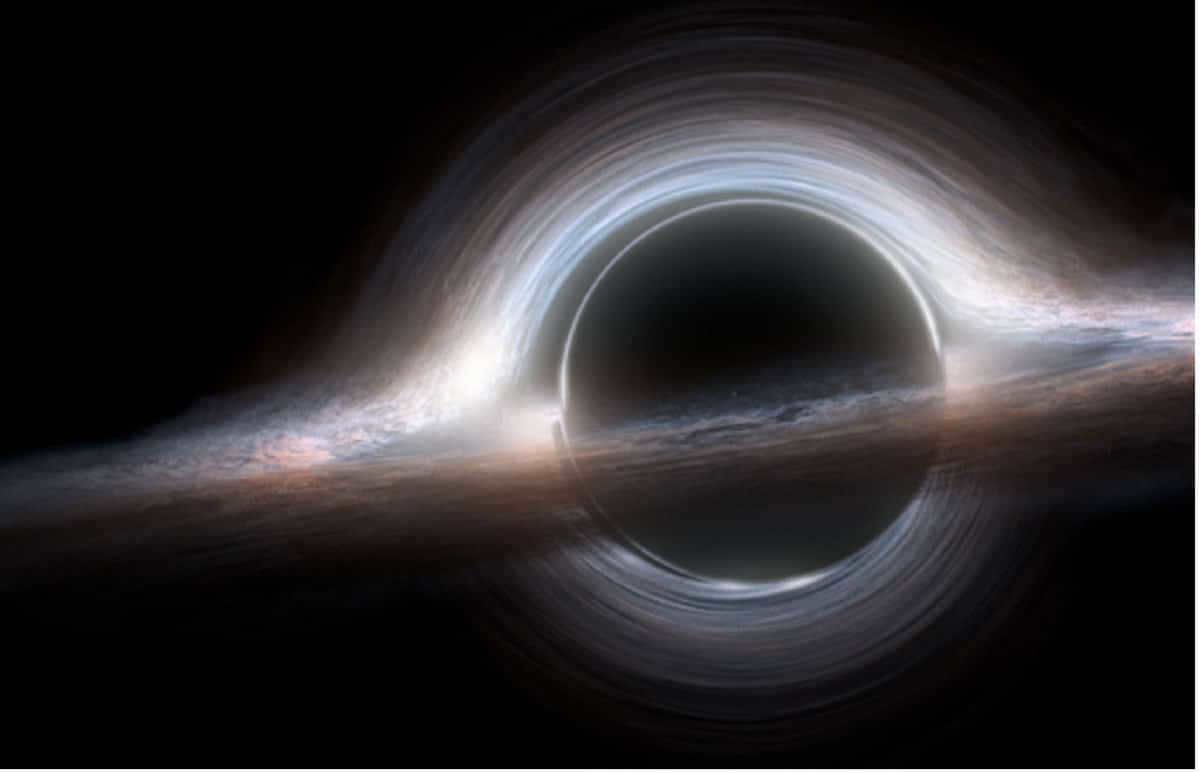
When discussing the initial photograph captured of a black hole, there is a concept referred to as the event horizon. This is the ultimate silhouette just prior to the profound darkness, possessing the ability to absorb all light and prevent its escape. Numerous individuals are curious about its significance and implications.
As a result, our objective in this article is to provide comprehensive insight into the characteristics, origins, and significance of the event horizon.
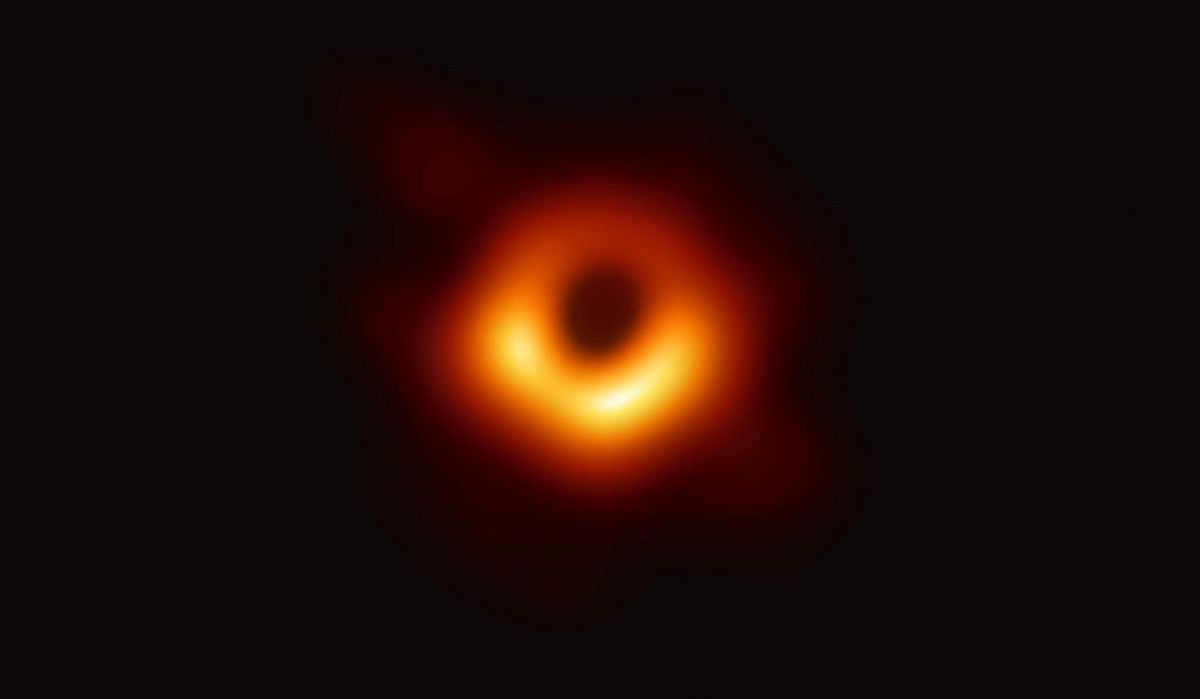
It is important to note that black holes have the ability to contain all matter and space-time within them. In addition to trapping light, they also possess such intense gravity that it magnifies everything we have discussed. The black holes themselves are completely devoid of any distinguishing features and appear completely black. Until now, they may have gone unnoticed due to the immense impact they have on their surroundings. They are also renowned for their immense energy.
This is why the initial contact with a black hole was made through the utilization of a network of radioscopes. These radioscopes are capable of measuring radiation from outer space. Unlike a telescope, they do not provide a direct view of the universe. In order to specifically detect the two black holes, fluoroscopes were employed. One of these black holes is the supermassive black hole located at the center of our galaxy, while the other is the core of the M87 galaxy.
Thanks to advanced computer software, it is now possible to convert data acquired from radio telescopes into visual representations. This technological breakthrough enabled scientists to capture the very first image of a black hole.
A boundary beyond return
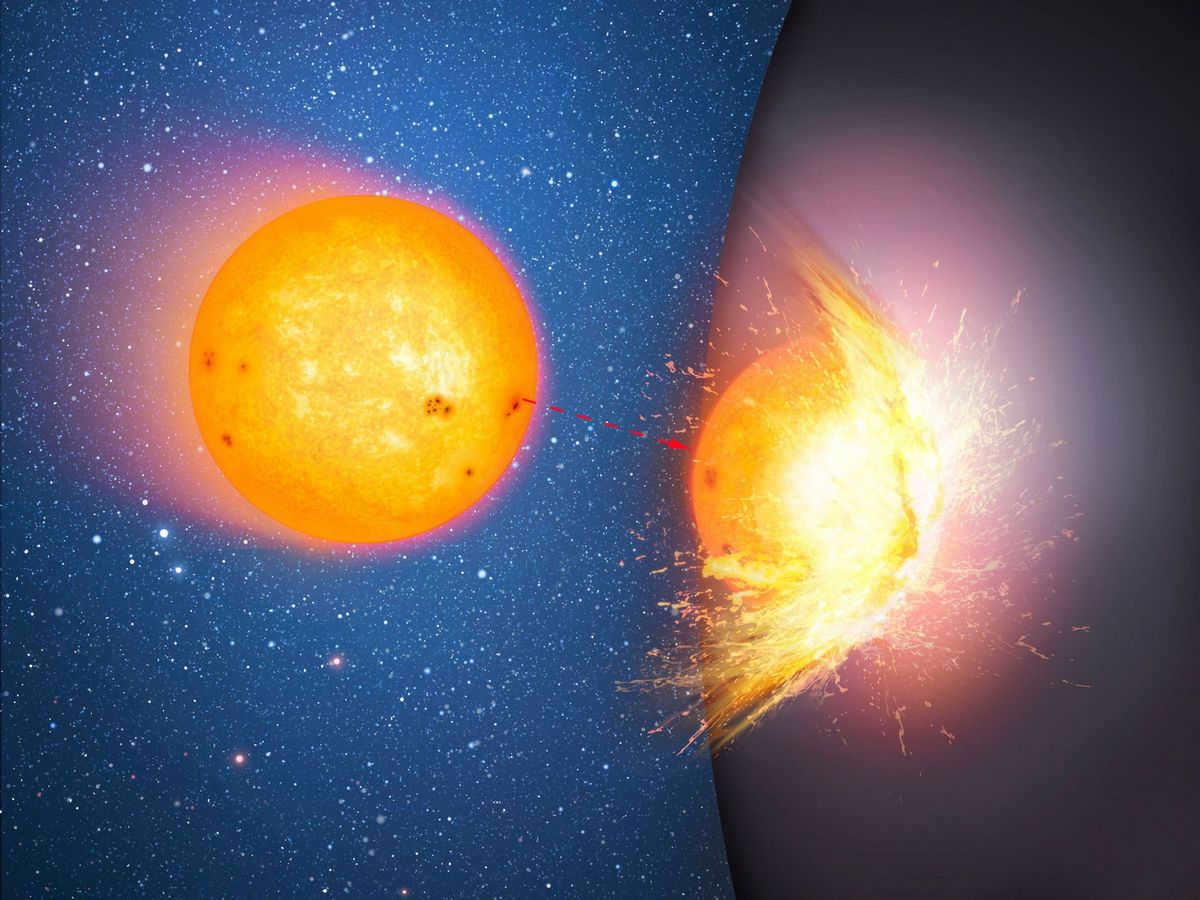
It is important to consider that nothing can be observed inside a black hole. The only observable evidence is the radiation emitted by the swirling gas in its vicinity. This gas is extremely hot and generates a significant amount of radiation. This radiation has the ability to penetrate the surrounding dust clouds of any black hole. The visible shadow provides insights into the curvature of spacetime in the immediate vicinity of the black hole.
Following all of this is the event horizon. It should be emphasized once again that there will be no visible lights or streaks that can be identified. The key thing to understand is that the event horizon is a conceptual boundary. If it were possible for us to cross the event horizon, we would not perceive any changes. This is because it is not a physical surface, but rather the point of no return for the black hole. Consequently, there is only one direction we can go from here: continue to descend into the black hole with no possibility of turning back.
Black holes possess an immensely strong gravitational force that attracts all matter within their vicinity. The mass and density of black holes are so immense that they exert tremendous pressure.
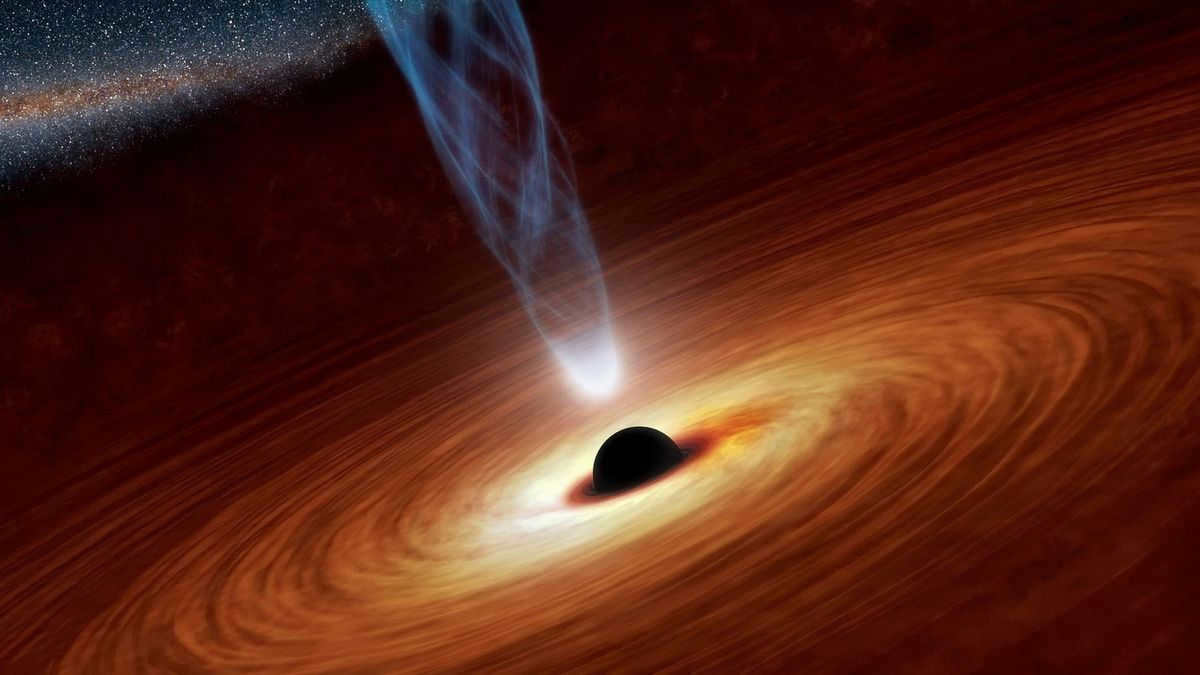
Let’s provide a somewhat more theoretical explanation to help illustrate the properties and nature of the event horizon. Please bear in mind that the event horizon is connected to the object’s escape velocity. We are referring to the velocity at which an imaginary individual would enter the black hole. That’s the velocity they would need to surpass the gravitational pull of the black hole. As someone approaches the black hole, they will require greater velocity to break free from its intense gravitational force.
One can describe the event horizon as the boundary surrounding a black hole where the velocity required to escape exceeds the speed of light. As of now, no object or entity has been found to possess a velocity surpassing that of light. This concept is evident in Einstein’s special theory of relativity. As the theory does not allow for any entity to move at a velocity greater than that of light, it implies that the event horizon of a black hole functions as a point of no return. The term “event horizon” signifies the impossibility of observing any event occurring within this boundary. It represents a horizon beyond which one’s vision cannot extend.
Imagine a theoretical explorer venturing beyond the event horizon. As postulated by the theory, the total mass of the entity has compressed into an infinitely dense expanse. Consequently, the fabric of our familiar spacetime is entirely contorted. In fact, it curves infinitely. Within this singularity, past the event horizon, the established laws of physics, as per Einstein’s theory, cease to exist.
Complete Discovery
Scientists have achieved the remarkable feat of capturing an image of something that was once thought to be purely hypothetical. Until recently, black holes were merely a theoretical concept used to explain specific phenomena in the cosmos. However, thanks to cutting-edge technology, we are now able to obtain the first-ever photograph of a black hole.
This groundbreaking achievement represents a major leap forward for the field of science. It is important to note that numerous textbooks on the subject of the universe will need to be revised. The wealth of knowledge we currently possess about the past necessitates our perpetual pursuit of updating our understanding of the universe.
By reading this information, you will be able to expand your knowledge on the event horizon and its properties.
The content of this article aligns with our editorial ethics guidelines. If you notice any errors, please click here to report them.
Comprehensive Summary of the Article: Network meteorology " astronomy " Event Horizon
Space-time serves as the backdrop for the entire cosmic chronicle: starting from the colossal explosion known as the Big Bang, traversing the formation of our very own galaxy, the Sun’s emergence, and the reign of the dinosaurs, all the way to the era of Alexander the Great and the advent of electronic popular science publications. The term “continuum,” derived from the Latin word for “uninterrupted,” is frequently used to describe space-time – yet in certain regions, it is also severed. In these locales, the customary laws of physics cease to hold sway. Time adopts an altered state. The concept of “here” loses its meaning as there is no physical presence. This domain exists as an ethereal realm of nonexistence, perpetually beyond reach. It represents a gravitational singularity.
The allure of geometry
Ever since the days of the ancient Greeks, space has held the perception of being unchanging, consistent, uniform, and time – a disconnected cyclic spiral of perpetual recurrence. As the era of scientific and technological advancements dawned, these notions became even more deeply ingrained. The Cartesian coordinate system mapped out the world with three orthogonal axes, while time was straightened out into a separate, independent straight arrow unrelated to space (or anything else, for that matter). To a large extent, we still inhabit the same perceptions that originated in the 18th century.
Einstein’s groundbreaking ideas were primarily centered around the recognition of two fundamental principles that fundamentally challenge conventional notions of time and space. Firstly, he realized that time and space are intrinsically linked and form a unified fabric known as space-time. Secondly, he acknowledged that this space-time continuum is not static and immutable, but rather subject to deformation when exposed to any form of energy, be it mass or otherwise.
Imagine expanding this example to include four dimensions (three spatial dimensions plus one temporal dimension) – and you will have a rough geometric representation of the real space-time. Please note that in areas where there is mass (or energy), the traditional coordinate axes no longer remain straight, and time itself becomes non-uniform for different observers. The concept of a straight line is ultimately just a mathematical concept: the most straight thing we observe in physics is the path of a light beam, the movement of a photon – but even that is affected by gravity. Matter that is affected by gravity moves along a locally straight path, but when observed on a larger scale, this straight path is actually a curve in a gravitational field.
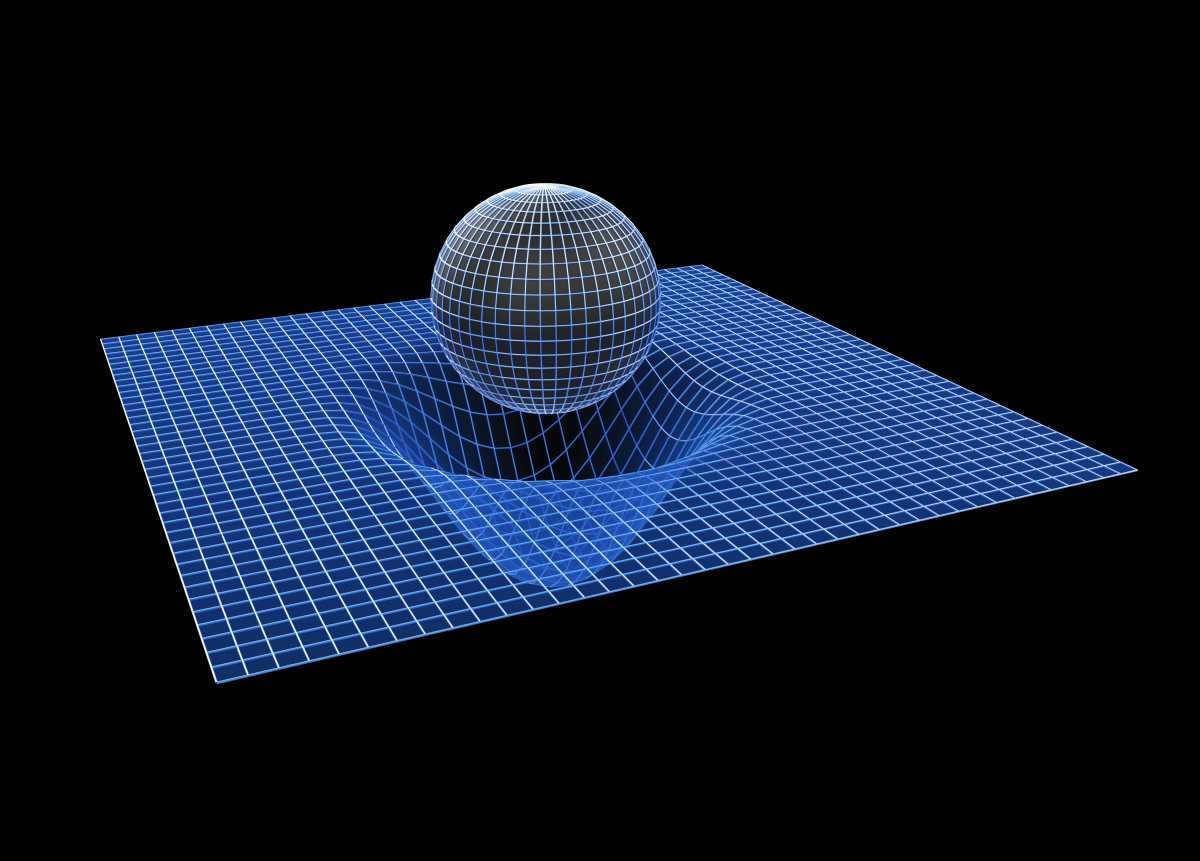
Shattering the Web
However, what happens if we launch an object heavier than a billiard ball onto the net from our geometric illustration? Let’s say a dumbbell, a weight of two pounds. It is highly likely that our illustrative model will not withstand this impact and will rupture, leaving behind only a void, threads, and fragments of the space-time continuum. This can be likened to a singularity.
Even in a philosophical sense, singularity can be seen as the opposite of continuity (the absence of gaps, quantization, fragmentation – NS). A singularity represents a one-time occurrence, a moment when events culminate in a unique outcome. It can be likened to an explosion, a fusion, or a liberation. At points of singularity, mathematical functions experience sudden changes in behavior: rapidly approaching infinity, fracturing, or abruptly reaching zero. If the variable X approaches zero and the corresponding function tends towards infinity, it signifies that you have entered a singularity. This is the domain where the seamless (continuous) structure of spacetime breaks down and something truly unimaginable occurs.
It is astonishing that the General Theory of Relativity itself sets the boundaries of its applicability: it “fails” in the singularity and beyond. As a result, the theory not only suggests the potential existence of gravitational singularities, but in certain instances, it necessitates their presence. Specifically, we are referring to black holes – entities with immense density, rendering them extraordinarily massive relative to their size.
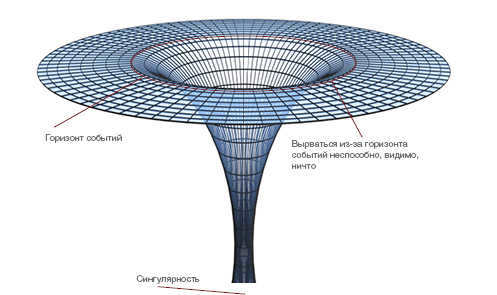
It is possible for a black hole to possess a mass similar to that of a massive planet or a billion massive stars. However, this mass solely determines the extent of the area surrounding the black hole where gravity is the dominant force. Within this region, nothing, including matter, radiation, and information, can escape. The Schwarzschild radius, which marks the boundary of this “point of no return,” defines the size of this region. On one side of the event horizon, the Universe abides by its own laws, while on the other side, the singularity reigns supreme.
Gravitational and cosmological phenomena
It is a common misconception that the laws of physics lose their validity in a singularity. In reality, the usual laws become inapplicable here, much like classical mechanics cannot explain the behavior of quantum particles. As German professor Klaus Uggla put it, the behavior of mathematical equations and functions in a singularity can be described as “pathological”. This can be observed by examining the behavior of particles in free fall.
No matter the nature or location of the particle, it has a tendency to follow the most direct path possible, which is only present under specific conditions. Whether in empty space, near the Earth’s surface, or beyond the event horizon, a particle only deviates from its trajectory when affected by external forces, such as gravity. However, within the singularity, the gravitational field becomes infinitely strong, causing the particle to… vanish completely.
In this instance, straight lines abruptly end (this characteristic of the singularity is known as geodesic incompleteness), and along with them, the particle’s destiny is terminated. As demonstrated by the esteemed mathematician Roger Penrose around 40 years ago, geodesic incompleteness should occur within any black hole. Later on, Stephen Hawking expanded upon Penrose’s calculations, applying these concepts to the entire Universe.
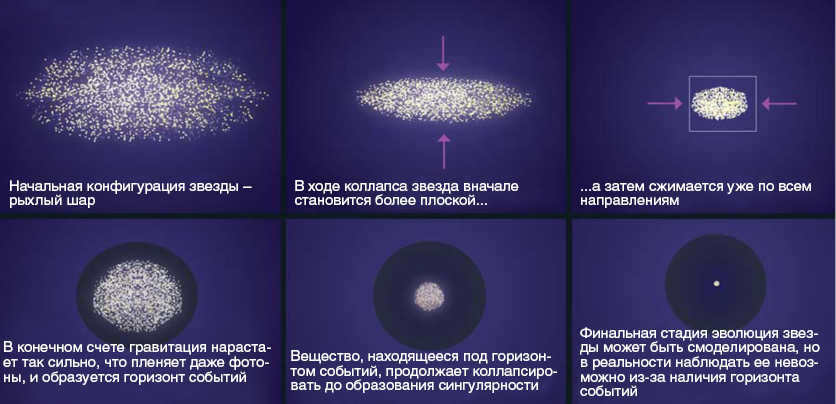
Indeed, at the start, there existed a singularity. Hawking demonstrated conclusively in 1967 that if one were to reverse any version of the solutions to the equations of General Theory of Relativity back in time, then at any point in the expanding Universe, we would inevitably arrive at this singularity. It is from the boundless demise of this “cosmological progenitor” that the seed of our space-time flourished.
Despite their captivating nature, the “Penrose-Hawking singularity theorems” merely suggest the potential existence of these phenomena. They offer no insight into what transpires within a black hole, what one might “observe” at its core, or what the Universe was like before the Big Bang. Consider Hawking’s cosmological singularity, for instance: it is presumed to possess both infinite density and infinite temperature, which are inherently incompatible. Infinite temperature implies infinite entropy, a gauge of system disorder, while infinite density signifies a tendency towards order.
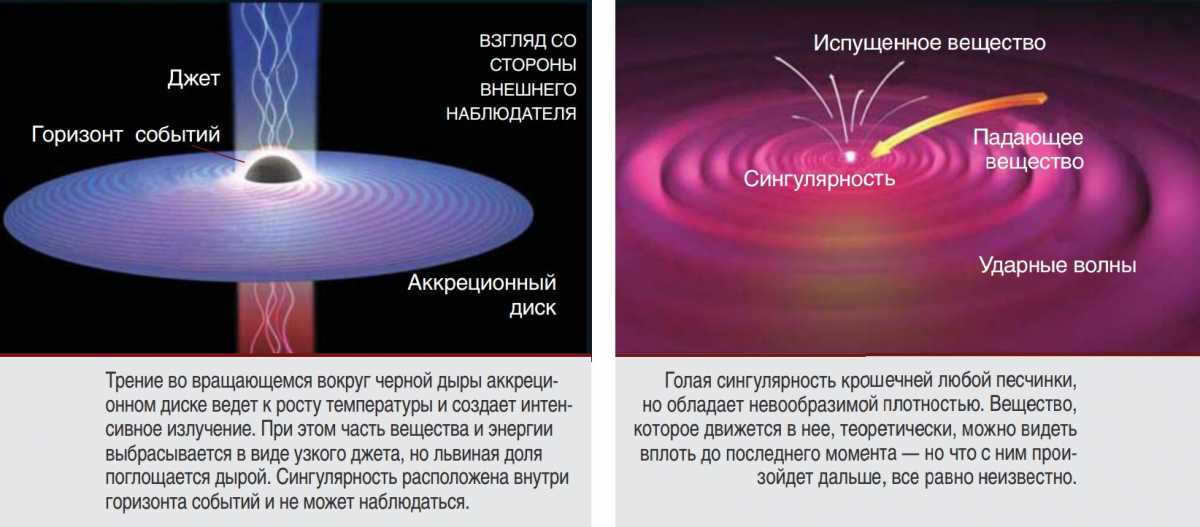
Unveiling the nakedness of the singularity
However, there are various peculiarities associated with the singularity. One noteworthy hypothesis, based on the general theory of relativity, is the concept of “naked singularities” – singularities that are not surrounded by an event horizon and can therefore be observed from the outside.
According to certain physicists, a regular black hole can give rise to a naked singularity. If the black hole is rotating at an extremely high speed, the singularity may manifest as a ring-shaped torus enclosed by an event horizon, rather than a point. As the rotation speed increases, the outer and inner horizons become increasingly close together until they eventually merge and vanish.
Regrettably, it is not feasible to directly observe a naked singularity in the real world; however, the concept is frequently depicted in science fiction. In the beloved film franchise “Battlestar Galactica,” one of the colonies inhabited by sentient beings orbits not a star or a planet, but rather a naked singularity.
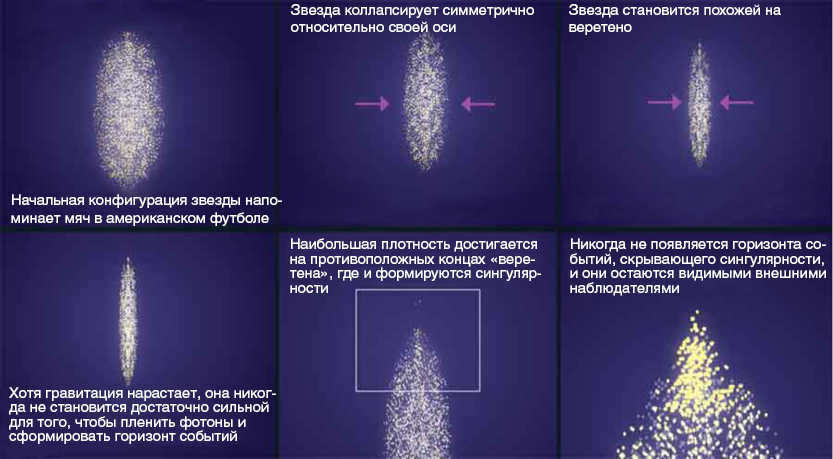
It should be mentioned that Roger Penrose brought forth the concept of cosmic censorship in the field of cosmology, proposing that there cannot exist any exposed singularities within the Universe. Penrose poetically expressed his viewpoint as “Nature does not abide naked singularities”. Although this principle continues to be unverified, it has also not been definitively disproven.
How to avoid entering a singularity
Using logical reasoning, we can deduce that we can never enter a singularity until the eventual demise of the Universe. Let’s envision a particle being pulled towards a black hole. As it accelerates and spirals closer, the gravitational force intensifies and its velocity increases, causing time to slow down according to Einstein’s equations. Eventually, the particle crosses the event horizon.
How much time does it take for this to happen? From an external observer’s perspective, it could be years. However, once the particle heads towards the singularity at the center of the black hole, spacetime around it becomes immensely distorted, causing time to practically come to a halt for the particle. Conversely, the passage of time for the Universe speeds up almost infinitely in comparison.
However, black holes have a limited lifespan. In the 1970s, Stephen Hawking demonstrated that due to a intricate interplay between gravity and quantum effects at the event horizon, black holes gradually evaporate and eventually vanish. It is possible that the particle will also vanish before ever reaching the singularity. Yet, this raises paradoxes akin to the ones encountered by Alice in Wonderland. For instance, where exactly is this particle located?
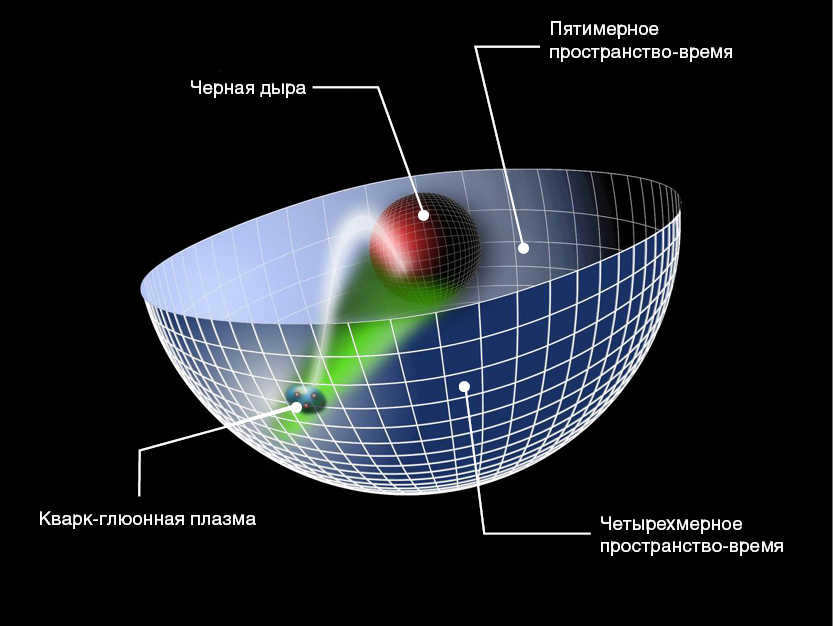
According to theoretical physics, black holes can be considered as void spaces. Although they have a boundary called an event horizon, there is nothing measurable, identifiable, or fixable beyond it – essentially, there is nothing at all. The total mass of a black hole is concentrated within a singularity, which is an incredibly tiny point enclosed by a sphere filled with an almost mystical darkness.
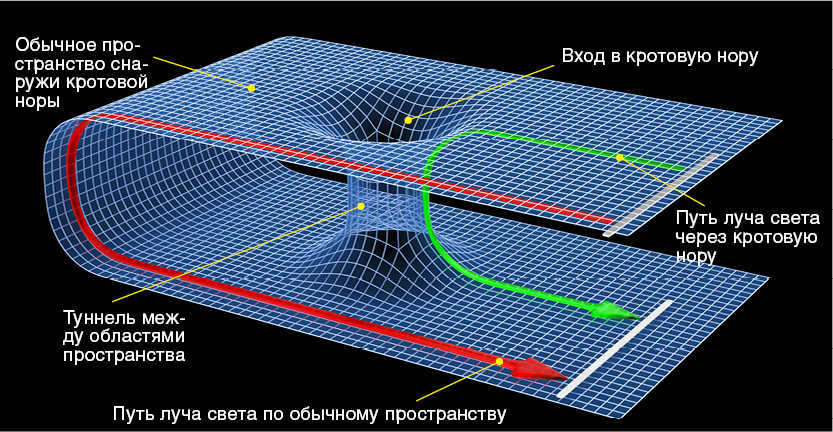
What’s hidden within?
There are certain theories that suggest that not only does the universe not allow naked singularities, but it also does not tolerate discontinuities in space-time. Consequently, each singularity could be a wormhole – a sort of anomaly, a passage connecting one region of the universe with another, metaphorically referred to as a “wormhole” or “time tunnel”. However, this remains merely a hypothesis, and it is uncertain whether we will ever have the opportunity to confirm or refute it.






